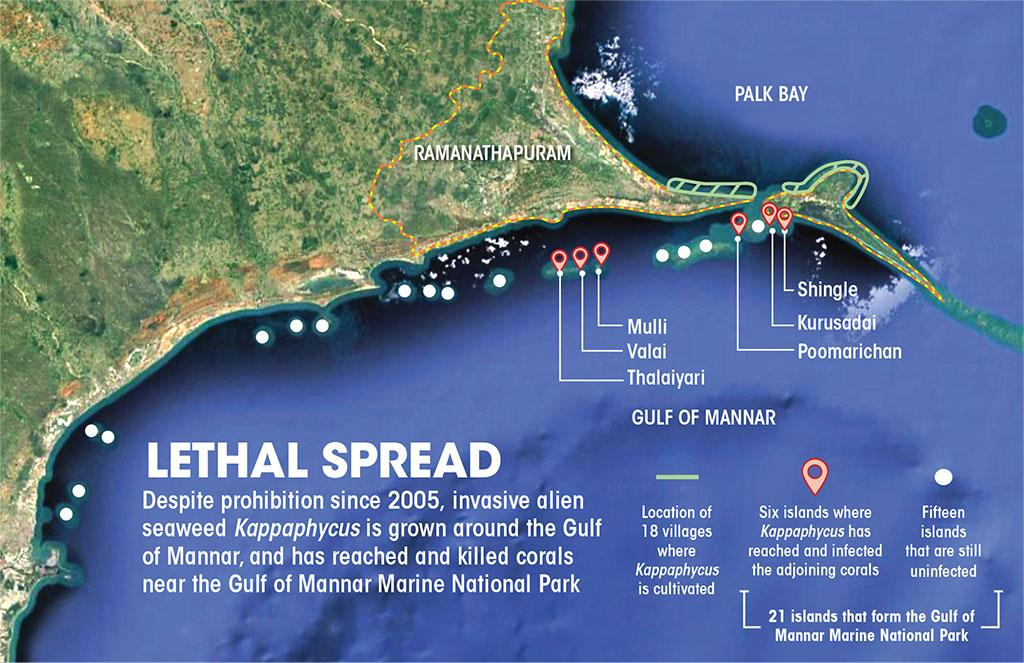Coral Breach in Gulf of Mannar | 20 Mar 2023
For Prelims: Coral reefs, Gulf of Mannar Marine National Park, Seaweed species, Tamil Nadu’s proposed Seaweed Park, Wildlife (Protection) Act, 1972.
For Mains: Seaweed Production in India, Issues Related to Corals.
Why in News?
Recently, the dead coral reefs were observed near Kurusadai (Tamil Nadu), one of the 21 uninhabited islands forming the Gulf of Mannar Marine National Park.
- The primary reason behind this loss is Kappaphycus alvarezii, a seaweed species deliberately introduced for commercial cultivation some two decades ago.
What are Seaweeds?
- About:
- Seaweed is the name given to the many species of marine algae and plants that grow in water bodies such as rivers, seas and oceans.
- They vary in size, from microscopic to large underwater forests.
- Seaweed is found on the shores across the world, but is more commonly a staple in Asian countries.
- Significance:
- Seaweed has numerous benefits, including being a source of nutrition, containing anti-inflammatory and anti-microbial agents for medicinal purposes
- Contributing to economic growth through its use in manufacturing, acting as a bioindicator by absorbing excess nutrients and balancing out ecosystems.
- Trapping excess iron and heavy metals and supplying oxygen and nutrients to other marine life forms.
- Seaweed Production in India:
- In 2021, India cultivated around 34,000 tonnes of seaweed, and the Centre earmarked Rs 600 crore to increase seaweed production to 11.85 million tonnes by 2025.
- Currently, about 750 farmers are engaged in seaweed farming, primarily Kappaphycus, in 18 villages of Ramanathapuram, Tamil Nadu and it is also likely to be cultivated in Tamil Nadu’s proposed seaweed park.
- National research institutes and companies are for increased cultivation of Kappaphycus to improve livelihoods, profits and to reduce India’s import of kappa-carrageenan.
- Impact of Kappaphycus alvarezii Seaweed:
- The Kappaphycus alvarezii seaweed species has invaded six of the 21 islands of the Gulf of Mannar Marine National Park in Tamil Nadu and has killed the corals near Kurusadai.
- It has also caused considerable damage to Coconut Island in Hawaii, Cubagua Island in Venezuela, Zanzibar in Tanzania, and Almirante and Cristobal in Panama and Costa Rica.
- The International Union for Conservation of Nature lists Kappaphycus alvarezii as one of the world’s 100 most invasive species.
- Gulf of Mannar:
- It is an inlet of the Indian Ocean, between southeastern India and western Sri Lanka.
- It is bounded to the northeast by Rameswaram (island), Adam’s (Rama’s) Bridge (a chain of shoals), and Mannar Island.
- It receives several rivers, including the Tambraparni (India) and the Aruvi (Sri Lanka).
- The gulf is noted for its pearl banks and sacred chank (a gastropod mollusk).
- It is an inlet of the Indian Ocean, between southeastern India and western Sri Lanka.
- Gulf of Mannar Marine National Park:
- The Marine National Park was established in 1982 under the provisions of the Wildlife (Protection) Act, 1972. Total area of the National park is about 162.89 km2.
- Major ecosystem types available are coral reefs, mangroves, mudflats, creeks, seagrass, & seaweeds, estuaries, sandy strands to saline grasslands, marshy areas and rocky shores.
Conclusion
The corals are an essential habitat for marine life, protect against storms, and support livelihoods through fisheries and tourism. Therefore, it is necessary to prevent the spread of Kappaphycus alvarezii seaweed to protect the Gulf of Mannar Marine National Park and its ecosystem.
UPSC Civil Services Examination, Previous Year Question (PYQ)
Prelims
Q. 1 "Biorock technology" is talked about in which one of the following situations?
(a) Restoration of damaged coral reefs
(b) Development of building materials using plant residue
(c) Identification of areas for exploration/extraction of shale gas
(d) Providing salt licks for wild animals in forests/protected areas
Ans: (a)
Q.2 Which of the following have species that can establish a symbiotic relationship with other organisms? (2021)
- Cnidarians
- Fungi
- Protozoa
Select the correct answer using the code given below.
(a) 1 and 2 only
(b) 2 and 3 only
(c) 1 and 3 only
(d) 1, 2 and 3
Ans: (d)
Q.3 Consider the following statements: (2018)
- Most of the world’s coral reefs are in tropical waters.
- More than one-third of the world’s coral reefs are located in the territories of Australia, Indonesia and Philippines.
- Coral reefs host far more number of animal phyla than those hosted by tropical rainforests.
Which of the statements given above is/are correct?
(a) 1 and 2 only
(b) 3 only
(c) 1 and 3 only
(d) 1, 2 and 3
Ans: (d)
Q.4 Which of the following have coral reefs? (2014)
- Andaman and Nicobar Islands
- Gulf of Kachchh
- Gulf of Mannar
- Sunderbans
Select the correct answer using the code given below:
(a) 1, 2 and 3 only
(b) 2 and 4 only
(c) 1 and 3 only
(d) 1, 2, 3 and 4
Ans: (a)
Mains
Q. Assess the impact of global warming on the coral life system with examples. (2019)

